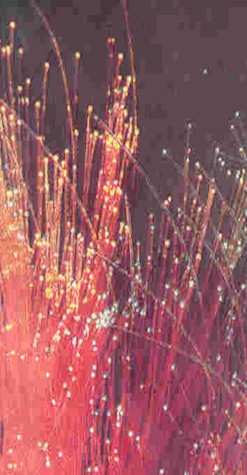Fiber Optics

Fiber Optics | 
|
Are you ever sitting at the computer and something just seems to take forever to download and you're in a hurry ... you just can't wait any longer! Your stomach is churning ... faster, faster you say, as you plead for mercy before the monitor in front of you !!
Dial up analogue, Cable Modem, ISDN, and fiber optics ... what does it mean to have all these different avenues for connection? It means that more will travel faster in a shorter period of time. What's the fastest? Fiber Optics of course!
And now we begin ...
Yes, it is the information age and they are tearing up the streets as I write so companies can install fiber optic cable for high-speed Internet use. The existing copper technologies will be something of the past as businesses replace copper with fiber optics which carry more data at higher rates of speed.
Congress passed the Telecommunications Act in 1996 and the rush to wire cities started. The law requires cities to allow companies to install fiber optic cable. In Washington, D.C., 12 firms are currently installing fiber optic cable under our neighborhood streets and more permits are pending according to the Department of Public Works.1
The telephone line that connects your home computer to the Internet now probably still pushes electrons through metal wires. But in the near future, the signals will be relayed through fiber optic cables by laser. Optical fibers are the best for transmitting signals at high speeds over long distances. The main difference between fiber optic commmunication systems and other types is that signals are transmitted as light. The light rays go in straight lines as optical fibers are used to guide them around corners.2 Fiber optics also are immune to electromagnetic interference which can block wire transmissions. And fiber optics can transmit both digital and analogue signals. Analogue signal transmission , however, requires linear light transmitters. Fiber optic cables are also more compact than old copper wire cables ... where only one wire cable can fit in an underground duct, four fiber cables can fit in the same space. As fiber cables are installed, extra fibers may also be included allowing room for future expansion.3
Glass and glass-like materials are used to manufacture optical fibers. Light traveling inside the center of the fiber reflects off the outside surface at an angle and then all the light returns to the fiber center without any loss.4 During the last four decades, great advances have been made in all areas of fiber optic performance. Manufactured fibers today are stronger, more efficient, less expensive, and they are able to transmit more wavelengths at much greater distance than fibers of earlier years.5
Since 1970 when Donald Keck, Robert Maurer, and Peter Schultz of Corning, Inc. invented the first optical fiber capable of transmitting light effectively enough for communications, telephone companies began purchasing and installing millions of miles of optical fiber around the world.6
The figures today are staggering:
"More than 90 percent of long distance and international voice along with internet traffic is carried by optical fiber. Most cable TV is distributed by optical fiber. More than 25 million miles of fiber is already installed in the United States, enough to circle the Earth and equator 1,000 times. About 50 million more miles are installed outside the United States. By 2005, the length of fiber linking continents under the seas will reach 360,000 miles, enough to circle the globe nearly 15 times. Optical fiber for communications is being installed worldwide at a rate of 3,000 feet every second, or 2,000 mph. This rate is more than twice the speed of sound."7
Fiber optic companies are sprouting everywhere today and more is being invested in the research and development of fiber optic technology. As the Internet evolves, more audio/visuals are used in web development for more interactivity and Internet traffic increases by leaps and bounds serving our government, educational institutions, businesses, media, our households and more. The ones and zeros of information coursing through the veins of communication networks will be ever increasing and fiber optic technology is amongst the solutions to minimizing arteriosclerosis on the Internet!
2: Understanding Fiber Optics by Jeff Hecht, copyright 1993 by Sams Publishing
3: Understanding Fiber Optics by Jeff Hecht, copyright 1993 by Sams Publishing
4: Encarta Encyclopedia (http://encarta.msn.com)
5: Fiberoptic Facts - Principles from Fiberoptics Technology, Inc. (http://www.fiberoptix.com)
6 :The Washington Post November 10th, 1999 article entitles, "Fiber Optics - Communicating at Light Speed" by Ivan Amato
7:The Washington Post November 10th, 1999 article entitles, "Fiber Optics - Communicating at Light Speed" by Ivan Amato